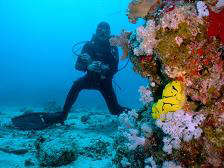This new phase of the project at False Bluff is called Las Tortugas, an appropriate title to give to a part of Nicaragua's coast where as many as five of the world's seven recognized species of turtles come to hatch...yes, sea turtles hatch at False Bluff.
The section of the Caribbean Coast where we're located is pristine and teeming with wildlife; and although it seems remote, it's only a few miles by water from the small and bustling port town of Bluefields. Unless you're actually in town, on foot or in a taxi, you travel by water - and that gets to be your norm really quickly.
There's a tropical-forest-edged lagoon to our back and the sea to our front with fishing, both salt and fresh water, and swimming, and hiking, and gardening, and bird-watching, and reading...a choice of activities limited mostly by your imagination.
Or you can choose to do absolutely nothing at all, which is a favorite pastime of mine...
At False Bluff we agree with Peter's philosophy about the land and extend that philosophy to the land in our stewardship - what he says about the fragility of the two Corn Islands applies equally to all of Nicaragua's Caribbean Coast; and so some covenants and restrictions will apply to lot use and building.
Peter's business philosophy and our long acquaintance are the reasons we've chosen him to act as our agent.
| helpful, reliable, trustworthy |    | ||||||||||||||||||
|
|
|
| ||||||||||||||||
     | |||||||||||||||||||
helps you to invest in Nicaragua's Caribbean Coast
| |||||||||||||||||||
Corn Islands
General InfosMaps
For Sale
Sites/LotsHouses Condominiums Commercials
For Rent
HousesCommercials
Atlantic Coast
BluefieldsPearl Lagoon
Mainland
|
Philosophy
The Corn Islands are a fragile biosphere and need a sustainable development, in which
economical, environmental and social aspects participate and improve synchronously. The
real estate has a high co-responsibility.
Integrity, honesty and knowledge of the local characteristics are the trademarks of my
business practice. Very important is time, attention and expertise for my clients, never to
pressure, but there to help you make the good decision.
 | ||||||||||||||||||
| Copyright 2005 - 2013 by Caribbean Dream Realty | |||||||||||||||||||
Our blog tells the ongoing story of False Bluff; and there's more information about both False Bluff and Bluefields at https://www.facebook.com/pages/False-Bluff/142899219245180.














